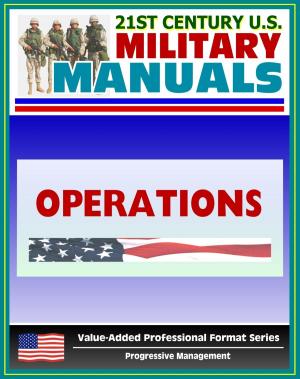A Survey History of Fort Bliss 1890-1940: Texas Army Installation, Spanish-American War, Mexican Revolution, World War I, Permanent Cavalry Post, World War II and Early Cold War Period
Nonfiction, History, Americas, Mexico, Military, United States| Author: | Progressive Management | ISBN: | 9781311938206 |
| Publisher: | Progressive Management | Publication: | July 5, 2016 |
| Imprint: | Smashwords Edition | Language: | English |
| Author: | Progressive Management |
| ISBN: | 9781311938206 |
| Publisher: | Progressive Management |
| Publication: | July 5, 2016 |
| Imprint: | Smashwords Edition |
| Language: | English |
This excellent report has been professionally converted for accurate flowing-text e-book format reproduction. This study reports on a preliminary effort to identify, evaluate, and document the historically significant roles Fort Bliss, Texas, has played in the history of the Southwest and the nation. Fort Bliss's 1890 to 1940 history can be divided into several significant periods; a chapter is devoted to each period. At the end of each chapter, a section is devoted to historically important questions relating to that chapter's subject matter. The bibliographic essays that follow each chapter review both the published secondary sources on Fort Bliss history and the primary manuscript sources that merit further analysis.
In the 50 years between the post's relocation at its present site and World War II, Fort Bliss gained regional and national significance. Fort Bliss became a great horse cavalry post and the most important U.S. military installation on the border. The army's horse cavalry era ended with the removal of the 1st Cavalry Division from Fort Bliss in 1943. Fort Bliss was the nation's last military base with a strategic mission as a horse cavalry post.
Fort Bliss's rise to prominence is intertwined with a series of historical events. Chapter I relates the first of these, the ending of the Indian wars in the late 1880s. Because fewer troops were needed in the country's interior, military forces could be moved to border garrisons. The first crucial decision in the history of modern Fort Bliss dates to this important shift in the army's strategic mission. Fort Selden, New Mexico, then rivaled Fort Bliss as a candidate for the region's most important post. However, impressed by Fort Bliss's strategic border location and its proximity to El Paso's railroads, the military decided to expand Fort Bliss in 1890. Crowded by railroad construction at Hart's Mill, the fort was moved to La Noria Mesa, its present location. The final appearance of the original post on La Noria Mesa largely was the work of the Quartermaster Officer Captain George Ruhlen. The first buildings were completed in 1893. They were first garrisoned in October, 1893; the rest of the decade passed quietly at the fort.
EXECUTIVE SUMMARY * PREFACE * FOREWORD * CHAPTER I - The Formative Years of New Fort Bliss (1890-1898) * Introduction * Fort Bliss 1890-1898 * Conclusion * Essay on Sources for Chapter I * CHAPTER II - Fort Bliss and the Spanish-American War Period (1898-1902) * Introduction * Fort Bliss 1898-1902 * Conclusion * Essay on Sources for Chapter II * CHAPTER III - Fort Bliss and the Early New Army Period (1902-1910) * Introduction * Fort Bliss 1902-1910 * Conclusion * Essay on Sources for Chapter III * CHAPTER IV - Fort Bliss and the Mexican Revolution (1910-1920) * Introduction * Fort Bliss 1910-1920 * Conclusion * Essay on Sources for Chapter IV * CHAPTER V - Fort Bliss and World War I (1917-1919) * Introduction * Fort Bliss 1917-1919 * Conclusion * Essay on Sources for Chapter V * CHAPTER VI - Creation of a Permanent Cavalry Post (1916-1920) * Introduction * Fort Bliss 1916-1920 * Conclusion * Essay on Sources for Chapter VI * CHAPTER VII - Fort Bliss in the 1920s * Introduction * Fort Bliss 1920-1929 * Conclusion * Essay on Sources for Chapter VII * CHAPTER VIII - Fort Bliss in the 1930s * Introduction * Fort Bliss 1930-1939 * Conclusion * Essay on Sources for Chapter VIII * APPENDIX * Fort Bliss in World War II and the Early Cold War Period * Fort Bliss in World War II * Introduction * Fort Bliss in World War II * Summary * Fort Bliss in the Early Cold War Period * Introduction * Fort Bliss in the Early Cold War Period * Summary * Conclusion * Essay on Sources for the Appendix
This excellent report has been professionally converted for accurate flowing-text e-book format reproduction. This study reports on a preliminary effort to identify, evaluate, and document the historically significant roles Fort Bliss, Texas, has played in the history of the Southwest and the nation. Fort Bliss's 1890 to 1940 history can be divided into several significant periods; a chapter is devoted to each period. At the end of each chapter, a section is devoted to historically important questions relating to that chapter's subject matter. The bibliographic essays that follow each chapter review both the published secondary sources on Fort Bliss history and the primary manuscript sources that merit further analysis.
In the 50 years between the post's relocation at its present site and World War II, Fort Bliss gained regional and national significance. Fort Bliss became a great horse cavalry post and the most important U.S. military installation on the border. The army's horse cavalry era ended with the removal of the 1st Cavalry Division from Fort Bliss in 1943. Fort Bliss was the nation's last military base with a strategic mission as a horse cavalry post.
Fort Bliss's rise to prominence is intertwined with a series of historical events. Chapter I relates the first of these, the ending of the Indian wars in the late 1880s. Because fewer troops were needed in the country's interior, military forces could be moved to border garrisons. The first crucial decision in the history of modern Fort Bliss dates to this important shift in the army's strategic mission. Fort Selden, New Mexico, then rivaled Fort Bliss as a candidate for the region's most important post. However, impressed by Fort Bliss's strategic border location and its proximity to El Paso's railroads, the military decided to expand Fort Bliss in 1890. Crowded by railroad construction at Hart's Mill, the fort was moved to La Noria Mesa, its present location. The final appearance of the original post on La Noria Mesa largely was the work of the Quartermaster Officer Captain George Ruhlen. The first buildings were completed in 1893. They were first garrisoned in October, 1893; the rest of the decade passed quietly at the fort.
EXECUTIVE SUMMARY * PREFACE * FOREWORD * CHAPTER I - The Formative Years of New Fort Bliss (1890-1898) * Introduction * Fort Bliss 1890-1898 * Conclusion * Essay on Sources for Chapter I * CHAPTER II - Fort Bliss and the Spanish-American War Period (1898-1902) * Introduction * Fort Bliss 1898-1902 * Conclusion * Essay on Sources for Chapter II * CHAPTER III - Fort Bliss and the Early New Army Period (1902-1910) * Introduction * Fort Bliss 1902-1910 * Conclusion * Essay on Sources for Chapter III * CHAPTER IV - Fort Bliss and the Mexican Revolution (1910-1920) * Introduction * Fort Bliss 1910-1920 * Conclusion * Essay on Sources for Chapter IV * CHAPTER V - Fort Bliss and World War I (1917-1919) * Introduction * Fort Bliss 1917-1919 * Conclusion * Essay on Sources for Chapter V * CHAPTER VI - Creation of a Permanent Cavalry Post (1916-1920) * Introduction * Fort Bliss 1916-1920 * Conclusion * Essay on Sources for Chapter VI * CHAPTER VII - Fort Bliss in the 1920s * Introduction * Fort Bliss 1920-1929 * Conclusion * Essay on Sources for Chapter VII * CHAPTER VIII - Fort Bliss in the 1930s * Introduction * Fort Bliss 1930-1939 * Conclusion * Essay on Sources for Chapter VIII * APPENDIX * Fort Bliss in World War II and the Early Cold War Period * Fort Bliss in World War II * Introduction * Fort Bliss in World War II * Summary * Fort Bliss in the Early Cold War Period * Introduction * Fort Bliss in the Early Cold War Period * Summary * Conclusion * Essay on Sources for the Appendix















